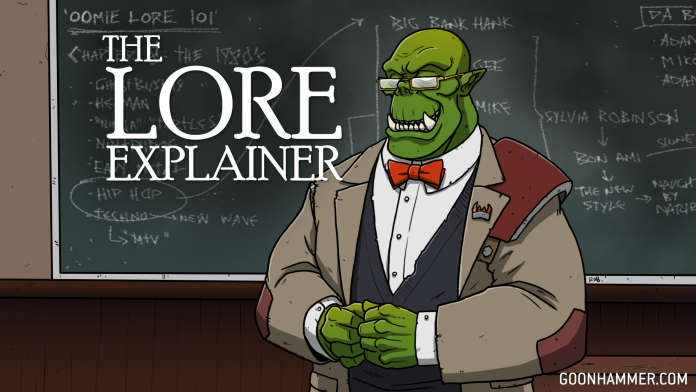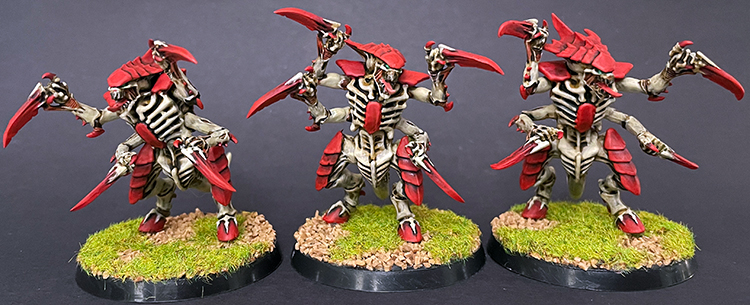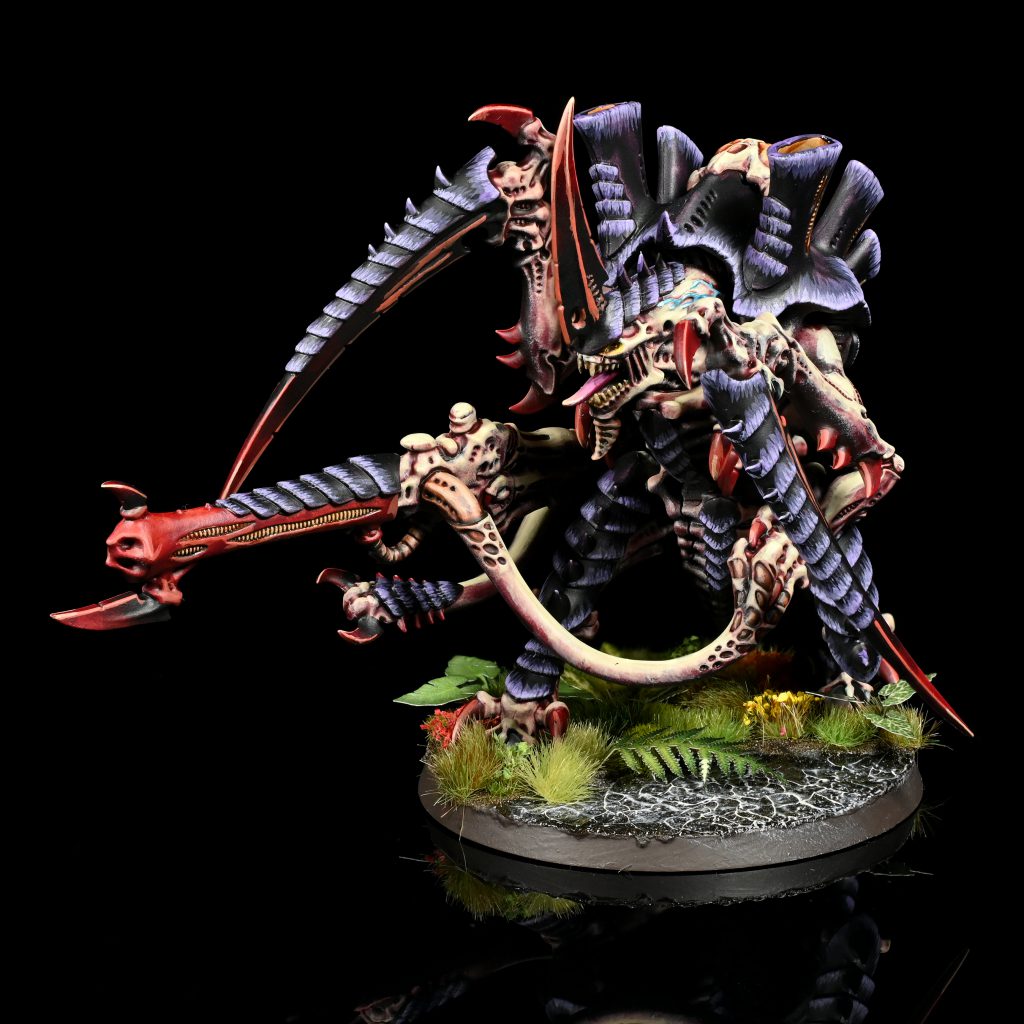In Lore Explainer, we take a deep look at the lore behind our favorite games, movies, and books, and talk about the story behind them and sum up what you need to know and how you can find out more.
With 10th edition on our doorstep, Games Workshop have shifted the narrative focus away from Abaddon’s attempts to push the Imperial Doomsday clock one minute closer to midnight and instead are looking at a new threat posed by the Tyranid menace, but from an older hive fleet. So as we once again dive into the existential threat posed by the skittering, chittering Tyranid menace, we wanted to take a moment to look at how we got here, and talk about the history between the noble Ultramarines and the ravenous Tyranids.
Before we begin, we should note that this was written with a preview copy of Leviathan supplied by Games Workshop for review purposes.
With that out of the way, let’s have an extremely brief Xenology lesson to fill you in on the finer details of the creepy crawlies coming out of the darkness.
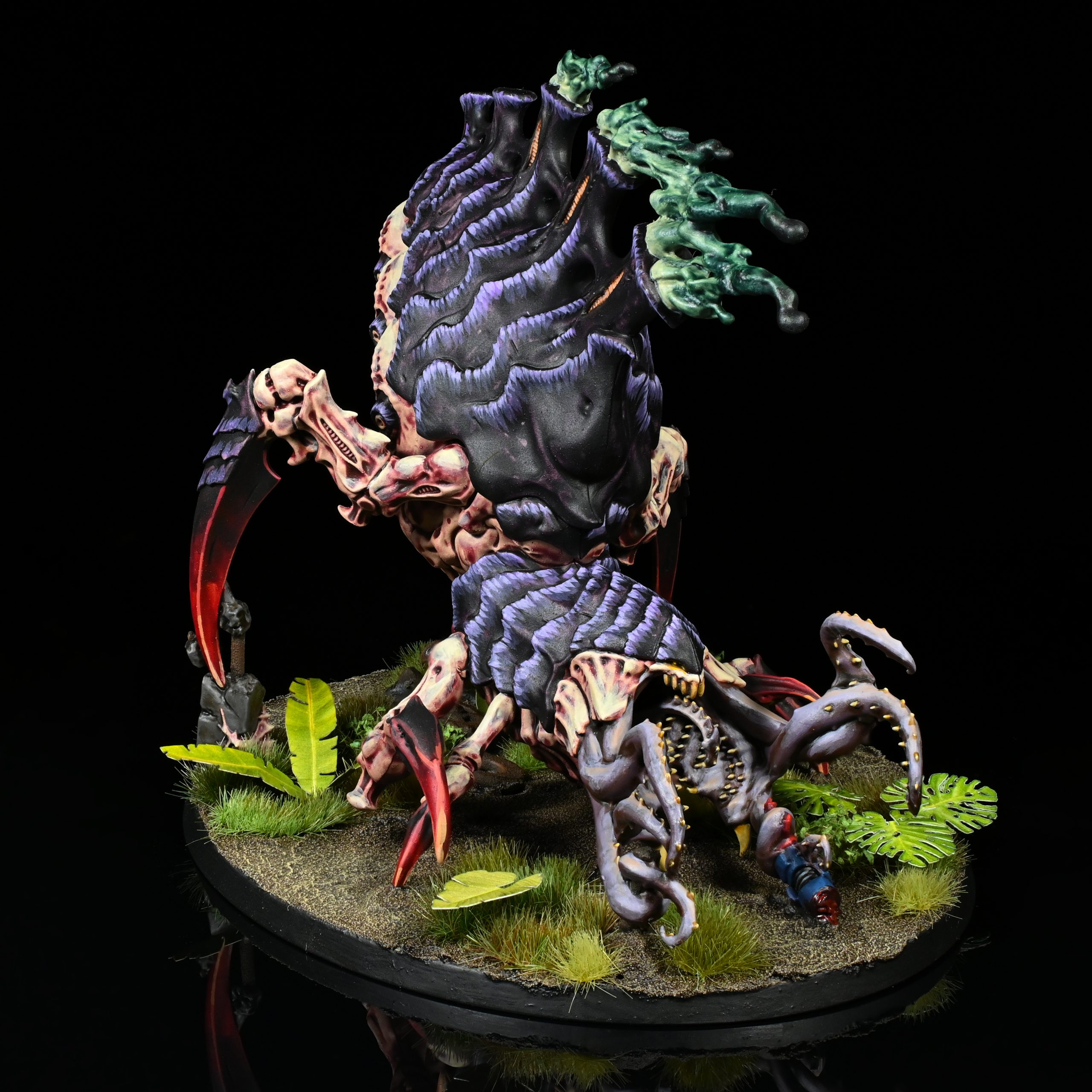
What is a Tyranid, Anyway?
We’ll dive into Tyranid physiology more in a future Lore Explainer but for now you need to know that Tyranids are xenos bioforms originating from outside the Milky Way galaxy, driven by an unending desire to devour and digest all the organic matter they come across. While it’s tempting to think of each horrifying creature as a distinct entity, that’s not strictly accurate; it might be better to conceive of each invading Tyranid hive fleet as a kind of mega-organism consisting of trillions of individual specialised parts controlled by a sort-of gestalt consciousness.
When Tyranids come into contact with other species, they have a tendency towards throwing endless swarms of monstrous horrors into the meat grinder without caring much about losses. Why? Well, if the Tyranids win, they’ll digest all the biological material on the planet, including the corpses of their fallen fighters (talk about loyalty!) – effectively sterilising the planet before moving onto the next world in their way.
How they Got Here
The Tyranids are a threat from outside our galaxy and while they may have arrived here regardless, there is one specific event (and person!) we can point to as the catalyst for their invasion.
Specifically, we can thank Loyalist Warsmith Dantioch of the Iron Warriors. During the Horus Heresy, Roboute Guilliman and the Ultramarines were using a “stellar lighthouse” called the Pharos on the planet Sotha to navigate across Ultramar. You see, those pesky Word Bearers had whipped up a Ruinstorm, making travel across the void a bit tricky. To stop their ships from bumping into things, clever Roboute made a mini-Astronomicon to light the way through the storm. Unfortunately, the Night Lords decided to try and take the Pharos for their own nefarious ends, and in order to save his best friend, Captain Alexis Polux of the Imperial Fists, Dantioch overloaded the Pharos Beacon. The resulting explosion sent out a massive psychic shockwave that traveled throughout space and eventually reached the fleets of the Great Devourer, who promptly interpreted it as as an all-you-can-eat buffet and changed course.
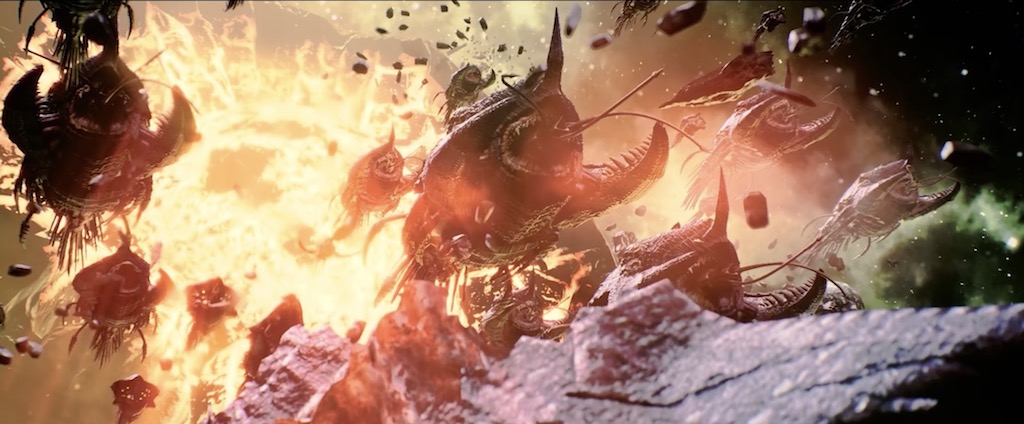
First Contact?
Reports of when humanity or the Aeldari first made contact with the Tyranids varies, and these reports are shrouded in uncertainty. Some records suggest that the first contact happened in M35, when humans and the Aeldari of Craftworld Iyanden discovered a massive, psychically-powerful alien megastructure on the jungle world of Ziaphoria. Others suggest that first contact was in M36, from which reports have emerged of winged horrors similar to those in Hive Fleet Ouroboris. And the T’au have likely been fighting off Hive Fleet Gorgon for centuries. And the moons of Ymgarl have famously housed Genestealers for ages, to the point that these creatures were once thought to be indigenous to the moons.
One point of contact we know for certain: In the year 39 996, the Blood Angels find a Space Hulk floating through the darkness of space, and go on board to take a look-see. What they find there are a lot of Genestealers who promptly kill almost all of the beautiful boys in red. Only a few manage to survive the massacre, including the most tired man in the galaxy, Dante. At this point, no-one knows the Genestealers are merely the secret vanguard of an approaching alien megafleet. Oops.
Six hundred years later, more Blood Angels find a Space Hulk called the Sin of Damnation (cue the foreboding horror film music), and spurred by their embarrassment at getting creamed by the Genestealers last time, they go whole hog on it by sending in a whole boatload of dudes in Terminator armour. This time the entire Blood Angels First Company manages to clean house, wiping out all forty thousand of the ‘stealers, before capping off that minor achievement by finding an ancient Blood Angels artefact. Neat! The Imperium still isn’t aware that the Genestealers are something more than simple outer-space greeblies. This is starting to look like negligence, guys.

Next, the Farseers of Craftworld Malan’tai get some intel from their Ranger buddies and decide that they should probably mosey and get out of the way of the oncoming storm of teeth and claws, which they do. By piloting their giant spaceship right into the path of another Hive Fleet, whoopsie!
The Fall of Tyran
Despite this millennia-long history, in terms of the Milky Way galaxy, encounters with the Tyranids are a relatively recent phenomenon, with first proven contact between the newcomers and humanity being recorded in the year 40,745. This particular case is the Fall of Tyran Primus, the planet which would give the invading fleets their name. Survey ships had already taken note of the planets around Tyran for they had notably been stripped of all organic matter and biological life, down to their bacteria. These surveyors would be the first ones to notice the massive swarm of unidentified objects entering the system – the first traces of Hive Fleet Behemoth.
Tyran itself was home to a heavily fortified Imperial Outpost and had several days to prepare, for all the good it did them. In what you might describe as “a particularly shit day” for the people station there, within 24 hours, the entire population and garrison had been slaughtered and turned into delicious Tyranid bio-soup to be digested slurped up by the Hive Fleet. Since the mind-powers of the Tyranid Gestalt loomed extremely large within the warp, casting a mighty long shadow, the station’s Astropath was unable to broadcast a distress signal, and so what had occurred was not known until the roaming Inquisitor Kryptman (who is quite a cool dude) visited the planet. Arriving on what had once been a lush Ocean world, he discovered that it had been completely stripped clean to such an extent that not even a single bacterium or drop of water remained.
Upon uncovering a data-log created by Magos Varnak, the station’s commander, in the final moments of his life, Kryptman was able to piece together what had happened to destroy the planet so utterly. In homage to the unlucky souls who made first contact, he christened the new organisms as “Tyranids” before hastening to Macragge to warn Marneus Calgar of the approaching threat. This is the start of the Tyrannic Wars.
‘We cannot live through this. Mankind cannot live through this. In a single day they have covered this planet with a flood of living blades and needle-fanged mouths. Kill one, and ten take its place. If they are truly without number, then our race is doomed to a violent death before every shred of our civilisation is scoured away by a force more voracious than the fires of hell themselves.
Death! By the Machine God,
Death is here!’
– Magos Varnak, last words
The First Tyrannic War Begins
‘An alien threat has risen from beyond the abyss, a swarm so vast that it blots out the stars. This horror fights neither for power nor territory, but rather to feed a hunger so insatiable that it will eventually devour the entire galaxy.’
– Inquisitor Kryptman
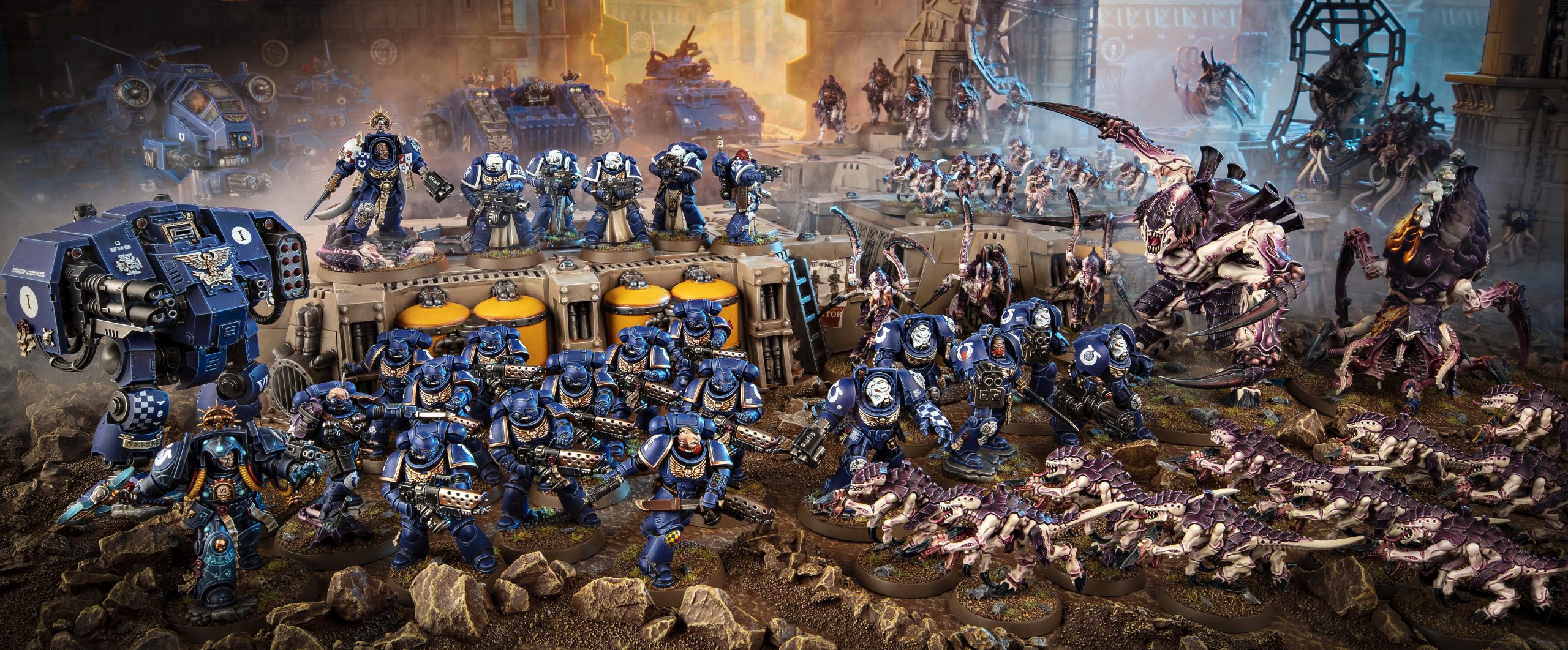
Kryptman attempted to send a warning message to the Imperium-at-large, but his own Astropath failed in the same way that the station’s had; the gestalt consciousness of the onrushing hive fleet was so vast that it created an impenetrable shadow in the warp, and since his party was behind the ravening horror, this blot severed their communications. Not really the kind of situation you want to be in, but hey, it’s probably better to be behind the hive fleet than in front of it. Kryptman and co. raced to a telepathic booster station but found that it too had been chomped by the insatiable Tyranids. Nevertheless, they cobbled together the damaged parts into a working booster matrix and, bleeding copiously from the nose and ears, the Astropath managed to punch a message through the shadow, informing the worlds of Ultramar of the approaching threat, giving the Ultramarines time to prepare for the claws and teeth hurtling their way.
Somehow, Kryptman managed to outpace the Hive Fleet, now designated “Behemoth”, to arrive in the Ultramarine system ahead of it, meeting with Marneus Calgar in person to inform him of his terrifying discoveries. Calgar set to work at once fortifying Macragge with a whole lot of guns, orbital platforms, strike cruisers, and a whole lot of space marines – the entire Ultramarines chapter standing ready to defy the foe, positioned alongside the formidable power of both the human Ultramar Auxilia and the Ultramar Defensive fleet.
Still, several worlds in the Ultramar system fell before the power of Behemoth – both the paradise world of Prandium and Calth were easily overrun and devoured in turn. Calth put up more of a fight; when a splinter of Hive Fleet Behemoth paid them a visit, the garrison managed to fight them off, with an Imperial Guard Commissar shooting the Carnifex leading the force through the eye with a plasma pistol (effortlessly cool, it wasn’t Ciaphas Cain, but it could’ve been!).
Notes
The First Tyrannic War was written for 2nd edition Warhammer 40k, when the Tyranids were first introduced as an army proper to the setting. You can find some of the best accounts of the war in Codex: Tyranids from that edition, but every codex since – including the 9th edition book – has at least a couple of pages devoted to this battle. Canonically, the Tyranids of Hive Fleet Behemoth are red with blue chitin plating.

The Battle for Macragge
Everything hinged on Macragge, the Imperium’s impassable eastern rimward bulwark, fortified still further thanks to the advanced warning of Kryptman. Should the Fortress world of Ultramar fall, the lightly defended worlds beyond would be easy prey for Behemoth, almost uncontested. As far as we know, Tyranids do not feel trepidation, and so despite the formidable guns of the orbital defences, Behemoth came on unabated, sending the colossal bioforms that might be called “ships” to make for the planet’s surface, rushing past the defences to deposit their living cargo into the atmosphere.
The newly-landed tide of living weaponry bore down on the Ultramarines like a tsunami of hungry Coconut Crabs, but the boys in blue held their ground, slowing the tide through the judicious application of bolt-fusillades and great big clouds of gunsmoke. It wasn’t to last. Without warning, Behemoth activated its trap card, deploying a new organism, dubbed by the Imperial defenders as the “Swarmlord”. The presence of this new threat transformed the mindless swarm of the Tyranids; where once they had charged endlessly into the teeth of Imperial cannonades, they began to avoid them, weaving around zones of fire to attack from the flanks. They began to concentrate on weak points in the human defences, judging and assessing which places to attack and which to ignore. The Hivemind Swarmlord observed and learned the entire gamut of Ultramarine tactics, anticipating and countering them like some kind of military genius. The Swarmlord came very close to killing Calgar, rending the Chapter Master’s body and leaving him on the brink of death. Only the timely intervention of his Honour Guard saved him as they rescued the Lord Macragge from the flashing blades of his foe.
While their brothers fought for their lives on the planet below, the voidcraft of the Ultramarines and the Ultramar Defensive Fleet fought a desperate space battle to repel the seemingly endless power of Behemoth. In spite of the complete obliteration of the orbital defences, Calgar proved himself not so easily cowed. The Tyranid fleet attempted to lure the defenders into a trap, pulling their vessels back in order to trick the human fleet into a pursuit. Calgar took the bait, chasing the Tyranid fleet towards the edge of the system, the Tyranids sprang their trap, revealing the hidden ships kept hidden in reserve among the rings of the planet Circe. Marneus Calgar was no fool, throwing down a metaphorical Uno reverse card as Battlefleet Tempestus popped into realspace behind the Tyranid fleet. Just as planned. Surprise!
Thanks to this pro-gamer move, which definitely wasn’t a lucky coincidence, Hive Fleet Behemoth was pounded from both sides and quickly found itself blown to pieces, with almost all of its bio-ships destroyed in the conflagration. Sadly, this destruction was not total, and some elements of Behemoth fled into the dark, perhaps to one day return to challenge anew the Bulwark of Ultramar. The Blue Boys had survived, but their wounds were grievous, with whole companies lying slain upon the ice or floating dead in the void of space.
The First Company died defending Macragge’s Polar Fortress, from whence the Chapter’s surface-to-space weapons were controlled. The legendary Saul Invictus himself fell in the battle, necessitating the promotion of Severus Agemman to lead this venerable body. Ortan Cassius, the Ultramarines’ Master of Sanctity, withdrew the Banner of Macragge during the rebuilding of the Chapter. It would not be flown again for 200 years. However, Calgar and Cassius would rebuild the Chapter stronger: Cassius created a new unit from the veterans of the Tyrannic War who specialized in fighting the alien menace. These heroes would often be assigned to the Deathwatch, who would mentor their cousins in the art of fighting the Tyranids. And the Ultramarines themselves would continue to fight the Tyranid menace, from planets as far afield as Tarses Ultra to Ba’al itself.
- The planet lived up to its name.
The Second Tyrannic War
While the first Tyrannic War had ended, there would be others. Hive Fleet Behemoth was only the beginning, and the Imperium would soon find itself embroiled in a new threat. While the assault from Behemoth had been clumsy and focused in a single fleet, the second major assault – from the Hive Fleet dubbed Kraken – would be more subtle, and divided among many different tendrils. Kraken would assault many different planetary systems at once, spreading its Shadow in the Warp over a wider area. Fleet swarms would make greater use of tunneling organisms and outflanking maneuvers and attack on more fronts than the Imperium could defend.
The Fall of Iyanden
Perhaps the greatest casualty of Hive Fleet Kraken was the Craftworld Iyanden, who had seen the approach of their doom through the skeins of fate. And while they knew it was coming, Craftworlds are ill-equipped to move quickly or through the warp, and so the Aeldari prepared for war. Every single member of the craftworld’s population mobilized for battle and they put up a ferocious defense, narrowly avoiding slaughter thanks to the intervention of Prince Yriel (previously exiled from the Craftworld) and his Corsair Fleet, who slew the Hive Tyrant leading the invasion swarm. Yriel earned his redemption among his people, but Iyanden’s population had been decimated. To this day the craftworld’s forces fight more with wraith constructs, a legacy of the horrendous losses they suffered.
Ichar IV
Kraken would eventually be halted (though not eradicated) at the Imperial world of Ichar IV – Also in the Ultima Segmentum. Ultramarines Chapter Master Marneus Calgar, having learned much from the battle against Behemoth, spearheaded the fight here, notable for being one of the first recorded instances of Tyranid Bio-Titans being deployed in a battle. Using the tactics he developed in the first war, the Imperial defenders were victorious, essentially smashing the bulk of Kraken’s fleet and leaving them with just splinter fleets.
Notes
The Second Tyrannic War – and Hive Fleet Kraken – were created for the third edition Codex: Tyranids, and that’s when their red-and-cream color scheme was introduced alongside a host of new metal models and a revamp of the Tyranids aesthetic that was decidedly more Aliens-inspired. This is also when GW released a series of units that took visual cues from the specific races the Tyranids had ingested, with models that resembled Orks (Biovores), Aeldari (Zoanthropes), and Space Marines (Tyrant Guard).
The Third Tyrannic War
Two wars wasn’t enough to refer to all of them by a group name so enter Hive Fleet Leviathan and the associated Third Tyrannic War. Leviathan was by far the largest hive fleet yet known, spreading farther across the galaxy than any before it. But third time out, the Imperium was a much better idea of what they were dealing with. Inquisitor Kryptman led the charge this time, throwing everything he had at the invading fleet.
Now before you go cheering, we have to note that Kryptman is one of those “the ends always justify the means”-type Inquisitors, and his strategy involved a lot of Exterminatuses. Specifically, his plan was to just kill planets before Tyranids could get there, so they’d end up starved and weak by the time they got to the real important worlds. This did not sit super well with the rest of the Imperium, who tended to balk at the concept of “trillions of deaths,” and it should be noted Kryptman’s methods only met with “some” success. He was declared Excommunicate Traitoris.
This would have stopped most Inquisitors (lol who are we kidding every novel about Inquisitors involves someone going rogue and blowing up the harbor after being told to hand in their badge and gun), but Kryptman still had some tricks up his sleeve. He set up the release of a bunch of genestealers in the Ork Empire of Octarius, drawing a tendril of Leviathan in that direction. Eventually the Tyranids would descend on the Orks and start a massive war that threatened to spill out across neighboring sectors. On top of that, Orks really enjoy a good scrap, and there was a legitimate concern that whichever side won would just end up stronger afterward.
Hoping to stop this all – or at least slow it down – is Inquisitor Sahansun, who helped coordinate a blockade/defense line around the war. They didn’t really succeed at this, but note that this is also happening in the “now” of the 40k universe – the situation is currently growing more dire by the day.

The Battle for Baal
The most famous/noteworthy campaign of the Third Tyrannic War was the battle for Baal, when a tendril of Hive Fleet Leviathan pushed into the Cryptus System, home to the Blood Angels’ homeworld of Baal. Responding to this threat, Dante mobilizes the entire Blood Angels chapter and also the Flesh Tearers, who are pretty rad and always up for helping out in a campaign book as a way to get back onto the page.
What followed is one of the cooler campaigns stories in 40k lore, with the Blood Angels initially repelling the Tyranids in part thanks to help from the Necrons. Yes, this is where that fist-dabbing meme of a Blood Angel and a Necron comes from: All this commotion wakes up the Tomb World under Perdita – a coreworld of the Mephrit Dynasty. As they wake, Anrakyr shows up to give them a proper “good morning” and inform that hey, if they don’t do something, Perdita will be destroyed by this massive Hive Fleet as well. They agree, and what follows is a heartwarming tale of togetherness and cooperation as Anrakyr meets up with Dante and proposes an alliance of convenience.
This doesn’t all go quite according to plan and things get desperate and in the process they activate a weapon called the Magnovitrium, which uses the shard of the Burning One and the Cryptus system’s entire star, Aeros, to unleash a devastating blast that incinerates the majority of the Tyranid fleet in a spear of flame that kills a bunch of people and also rips apart a bunch of the Tyranid fleet… but it basically dooms the system for everyone but the Necrons by destroying the star at its center. Well, maybe. I say “maybe” because it’s no longer clear if this particular event is canon or if it was rolled back in 9th.
What is canon is that after this, there were another 18 or so waves of Tyranids after that, pummeling the defenders until the Great Rift opened up. This is better news than you’d expect however, as a bunch of Khorne daemons pour out led by Ka’Bandha and in the mess, Dante kills the fleet’s Swarmlord as the Blood Angels make their desperate last stand. Then when everything seems completely lost, Guilliman finally shows up with the Indomitus Crusade and leads the drop assault to purge the Tyranids from Baal. The day is saved. For now, anyways.
The Great Rift
While all this is going on, Abaddon finishes the fight on Cadia and the Great Rift opens up, tearing the galaxy asunder and plunging half of the galaxy into “darkness”. This is good and bad for the Tyranids, who surged forward as Mankind was confused and reeling from the change, but also had to suddenly deal with a bunch of invading daemons who don’t provide corporeal bodies for them to eat and who taint the precious biomass they’re looking to devour. So welcome to the big fight against Chaos, Tyranids.
Notes
Hive Fleet Leviathan were introduced in 4th and 5th edition 40k and gave us the now-ubiquitous purple-and-cream color scheme we see in most of the official GW studio models. They were recently the subject of two major campaign books: The Shield of Baal series released in 6th/7th edition and the War Zone Octarius series from 9th edition. Both detail the wars against different tendrils of Hive Fleet Leviathan. If you’ve watched the Angels of Death series on Warhammer+, that takes place in and around the events of Shield of Baal. Shield of Baal is also where we’re first introduced to the Mephrit Dynasty for Necrons.
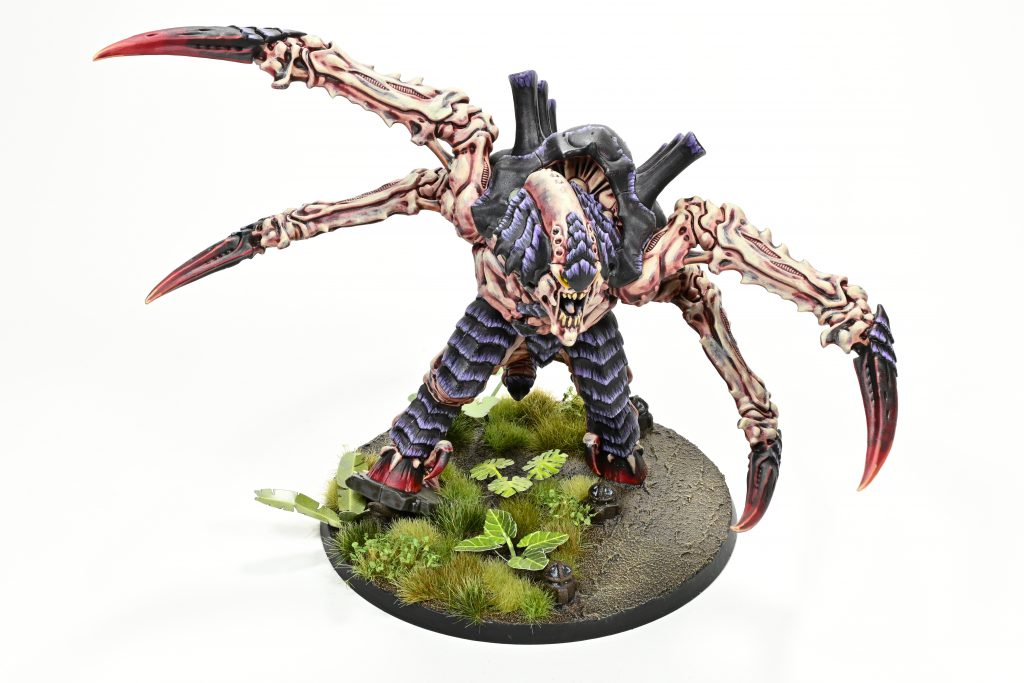
The Fourth Tyrannic War
As 10th edition launches, we’re looking at the dawn of the Fourth Tyrannic War and once again returning to Hive Fleet Leviathan, the largest and most deadly of the Tyranid fleets. This time however the battle is no longer occurring on some distant frontier world – the Tyranids are attacking from the galactic west, in Segmentum Pacifica, far closer to Terra than ever before. Imperial defenses were mobilized to meet them, led by smaller elite vanguard fleets called Solblades. These groups often numbered two or three warships apiece, led by and largely comprised of Space Marines, though they’d often include the Adepta Sororitas, Knight Households, Adeptus Mechanicus forces, and Custodes.
The current lore has the Solblades engaging with Hive Fleet Leviathan across the Bastior sub-sector, as more and more of Leviathan’s tendrils make their way up into the sector. See, the Tyranid fleets are thinking three-dimensionally, attacking the galaxy from above/below, as they aren’t dependent on the same methods of warp travel as the rest of the galaxy (their fleet ships manipulate gravity for FTL travel – slower, but more reliable than warp travel). This leads to problems with Grendyllus, the third tendril launched by Leviathan into the galactic west, which spears up into the galaxy behind the Solblades rushing out to meet the first two tendrils’ invasions.
Notes
Pretty much all of this is covered in the new rulebook in the Leviathan boxed set, or in the Tyrannic Wars supplement you can buy separately. This story covers the early days of the Fourth Tyrannic War, the plan to defend a series of achor worlds, and the desperate fight against Grendyllus. Because we’re in a different part of the galaxy, we get some new dramatis personae for a battle with Tyranids, and Trajann and Lord Solar Leontus get to take some screen time here, as well as a new Raven Guard character, Shadow Captain Sard Gaeron.

Evolving Lore
Both the Tyranids and their nemeses, the Ultramarines, go back a long way, to the earliest days of Warhammer 40K, and since then the key encounters between them have not changed much. This being said, the lore behind the specific factions has changed greatly. It isn’t hard to see the influence of the Alien franchise in the earlier Tyranid designs, and movies like Aliens or Starship Troopers reinforced the idea of Bugs vs Marines in the minds of the general public. Blizzard’s Starcraft is also iconic with their introduction of the Zerg, a race that perhaps bears more resemblance to the Tyranids than any other in fiction. It seems highly unlikely that these two haven’t influenced one another at some point in time.
While the origin of the Tyranids has remained shrouded in mystery for decades, the recent revelation that events during the Horus Heresy attracted them to the Milky Way is small but important detail in fleshing them out. Originally, the Tyranids were written as only being able to travel by sub-light speed, something that seems rather preposterous given their extragalactic origins and there being over 2 million light years between the Milky Way and its nearest neighbour. Coupled with the Pharos beacon being a sort of light in the dark to attract them, there’s a strong implication that their space faring capabilities are far greater than any other faction in the setting, and that they were likely already on their way.
Otherwise, Tyranid lore is easy to build on – as a faction they don’t have speaking characters and so they tend to act as the main antagonist in any conflict they’re in. This means the Tyranids have a lot of losses that are just battles in the larger war – one they seem destined to win eventually regardless of what happens. There are always more conflicts to add them to and the hive fleet is massive enough it can show up anywhere – case in point with Leviathan taking center stage once again in the 40k lore in a new part of the galaxy.
Being more akin to a living tide than an actual army Tyranids are a force where the rule of cool applies more than any other when contriving reasons for other factions to be facing them in open combat (or on the table). Desperate last stands or assaults on initial landing forces are perhaps the only time in which conventional military forces would find themselves in a face-to-face situation against Tyranids. Once a majority of a planet’s ecosystem has been subsumed into a growing swarm, no military force would have ammunition or manpower to stop them, with combat being more of a containment effort, prosecuted through calculated use of weapons of mass destruction to sterilise areas, similar to the way in which wildland firefighters try to control the spread of a wildfire.
Unfortunately this fire is alive, and intelligent.
Have any questions or comments? Have a lore topic you want us to cover? Drop us a note in the comments below or email us at contact@goonhammer.com.
